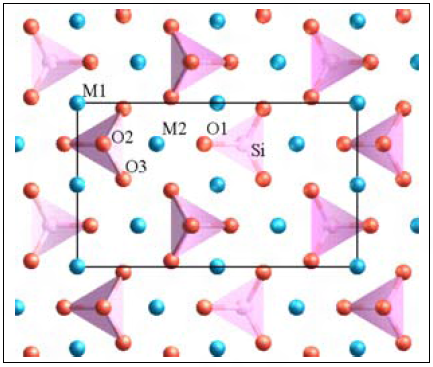Minerals
The mineral is a naturally occurring matter composed of a chemical substance that is formed during complex geological processes. Minerals are characterized by their chemical composition, specific physical properties, an ordered atomic arrangement.
Structures of various minerals

Structure of Proxene group of minerals

Structure of Olivine Group of minerals
There are several types of rock-forming minerals. Some have been listed below
- Quartz;
- Fluorite;
- Pyrite;
- Gypsum;
- Calcite;
- Mica;
- Galena;
- Feldspar;
- Hematite;
- Ulexite.
It is important to correctly identify minerals for engineering applications. Minerals determine the structure, strength, and other properties of materials. Since physical and chemical properties are considered when choosing materials for engineering purposes, it is necessary to identify minerals correctly.
Formation of rocks
Igneous rocks
Igneous rocks are formed when molten rock (magma or lava) cools down and solidifies. Due to high temperatures in the interior of the earth, rock melts to lava. Since the molten rock is less dense than the surrounding, it rises towards the surface. If the molten rock cools and crystallizes within the earth, intrusive igneous rocks are formed. If the lava rises to the surface due to eruption, it cools down, crystallizes, and forms extrusive igneous rocks. The texture of igneous rocks is determined by the rate of cooling of magma. Some have coarse grains while others are fine-grained. The major composition of igneous rock is silica. The percentage of silica in a rock determines the type of rock and its use. Most igneous rocks are hard, tough, and dense, which makes them suitable for most engineering works.
Sedimentary rocks
Sedimentary rocks are formed when rock particles from weathered rocks accumulate to form a new rock after a long time. It is formed through three major steps which include weathering, erosion, accumulation, and compaction. The major characteristic of sedimentary rocks is layers. The texture of these rocks is determined by the parent rock. Some do not have uniform texture due to the accumulation of different rock particles giving rise to detrital. Chemically formed sedimentary rocks have unique chemical compositions that are useful in engineering processes. Good examples are limestone and coal. Some sedimentary rocks have ripple marks especially those formed on the seashore.
Metamorphic rocks
Metamorphic rocks are formed when existing rocks are subjected to physical conditions of heat, pressure, and fluids for a very long time hence change the internal structure but not the chemical composition. The degree of metamorphism is reflected in the rock’s texture and composition. Some of the rocks exhibit a layer of branded appearance while others do not exhibit such layers or bands.
Mechanical and chemical weathering of rocks
Mechanical weathering is a process during which rocks are broken into smaller pieces by physical means caused by external forces. Plant and animal activity cause weathering. This occurs when plants grow into existing rock cracks, while animals like moles and rabbits dig holes that expose rocks to the effects of weathering such as water, ice, and air. Abrasion is the grinding of rock. This occurs due to the activity of wind, running water, and gravity. These agents push smaller particles of rock into large rocks causing pieces to chip off. Large rocks can fall due to gravity knocking other rocks and causing them to chip off. Ice wedging occurs when water seeps into rock cracks and freezes. Since water expands when it freezes, sections of rocks are broken off.
Chemical weathering occurs when a chemical reaction occurs and disintegrates a rock. The chemicals can be acidic rainwater, decaying plant and animals, and animal or industrial wastes. When acidic rain comes in contact with limestone, it reacts causing chemical weathering.

Several factors affect the formation of the soil profile.
- Parent Material. Hard and tough parent material takes longer to be weathered and cannot be weathered by weak physical conditions.
- Climate. Climate affects soil profile because of its contribution to weathering. High temperature and precipitation directly affect weathering.
- Time. After the soil has been formed, it may compact and eventually resemble the original parent rock.
- Topography. When the slope of a surface is steep, the rate of runoff, erosion is high hence increasing the rate of weathering, but when it is gentle the rate is lower.
- Vegetation. The plant holds soil in place. It also provides organic matter to the topsoil.
Faults, folds, strike, and dip
Faults are planar discontinuities, i.e. interruptions in the rock physical continuity due to induced stress.

The fold is a term used to identify the process when rocks on the earth crust due to the pressure which makes them curve or buckle.

The strike is the orientation of a rock outcrop i.e. the direction along which the bed of the rock trends.

The dip is the acute angle between an inclined plane an imaginary horizontal plane measured perpendicular to strike (it is measured as an angle and a direction and various from horizontal to vertical).

The anticline is a term used for a fold structure that has two limbs spread apart in a downward direction. On the other hand, a syncline is a two-limbed fold where the limbs are open upward.
According to the first rule, the youngest rock is on the top of the older ones. When sedimentary rocks are subjected to folding, erosion of anticline may occur with time. Different layers of rocks will be exposed on the earth’s surface. The oldest rock can be identified as the one in the middle of the fold.


